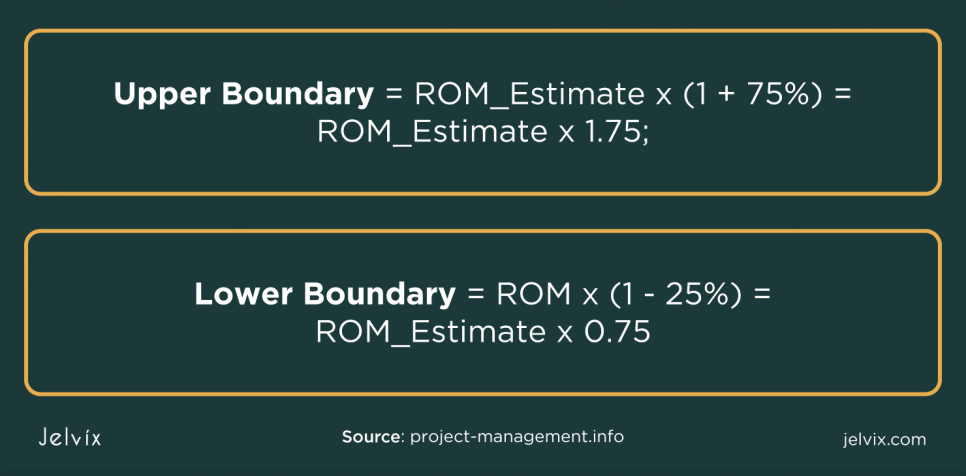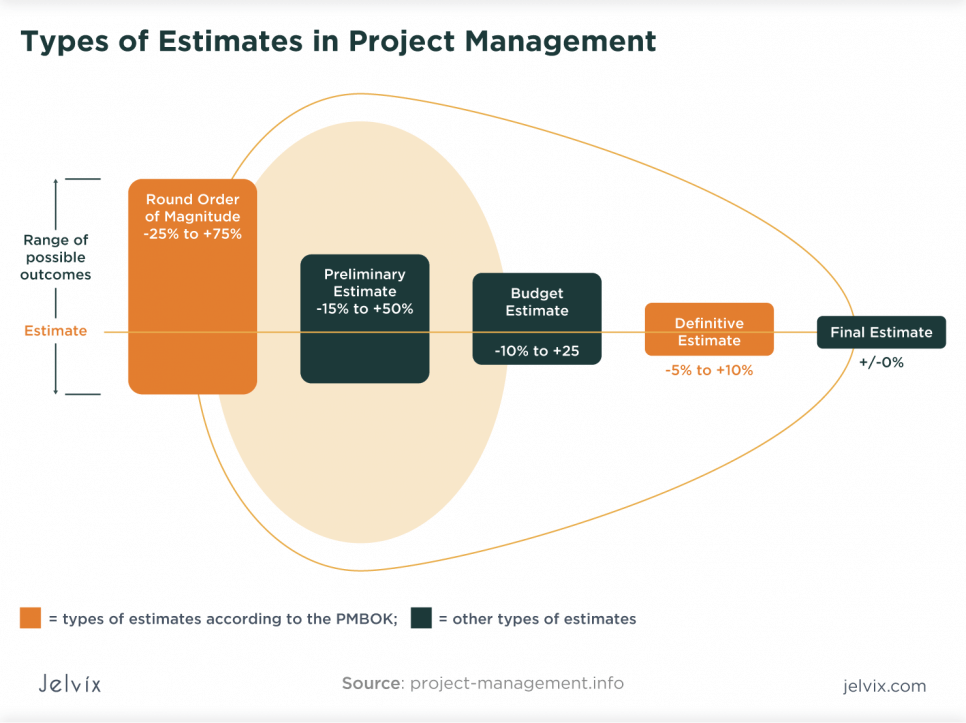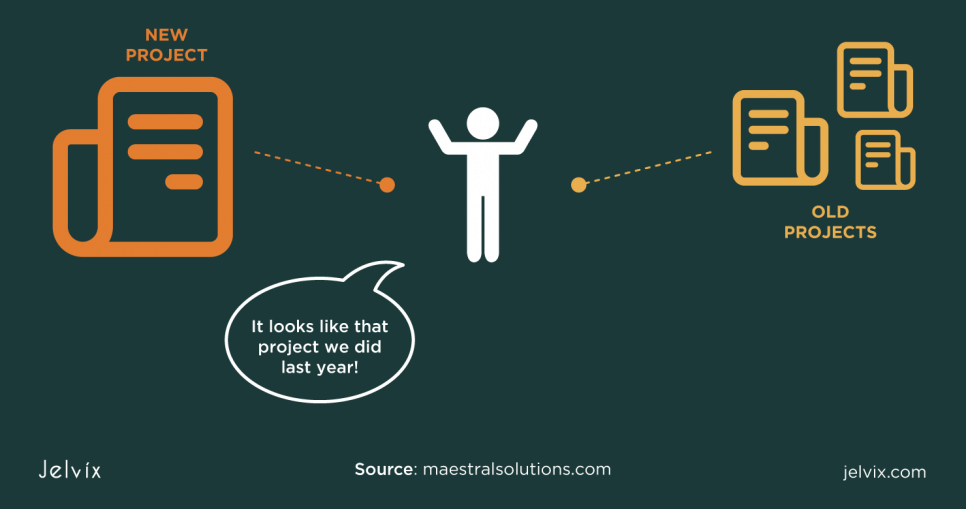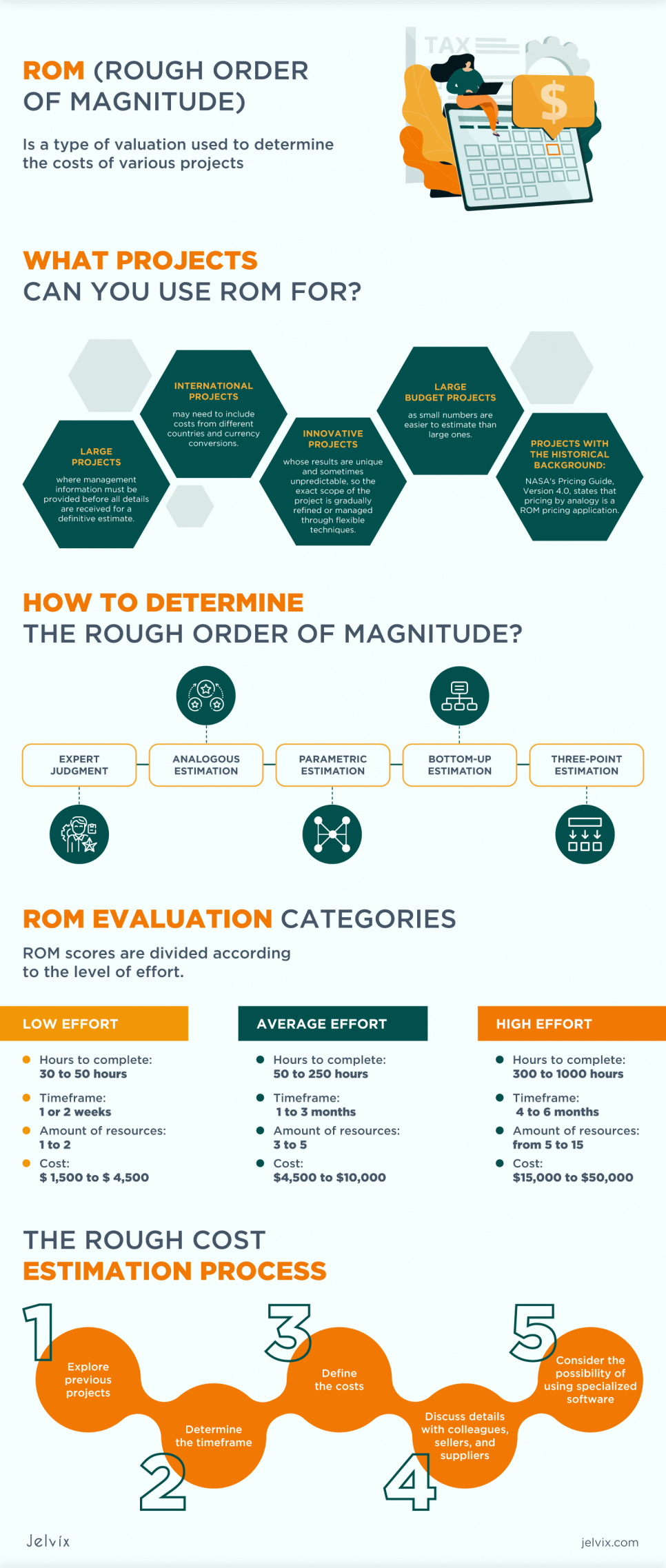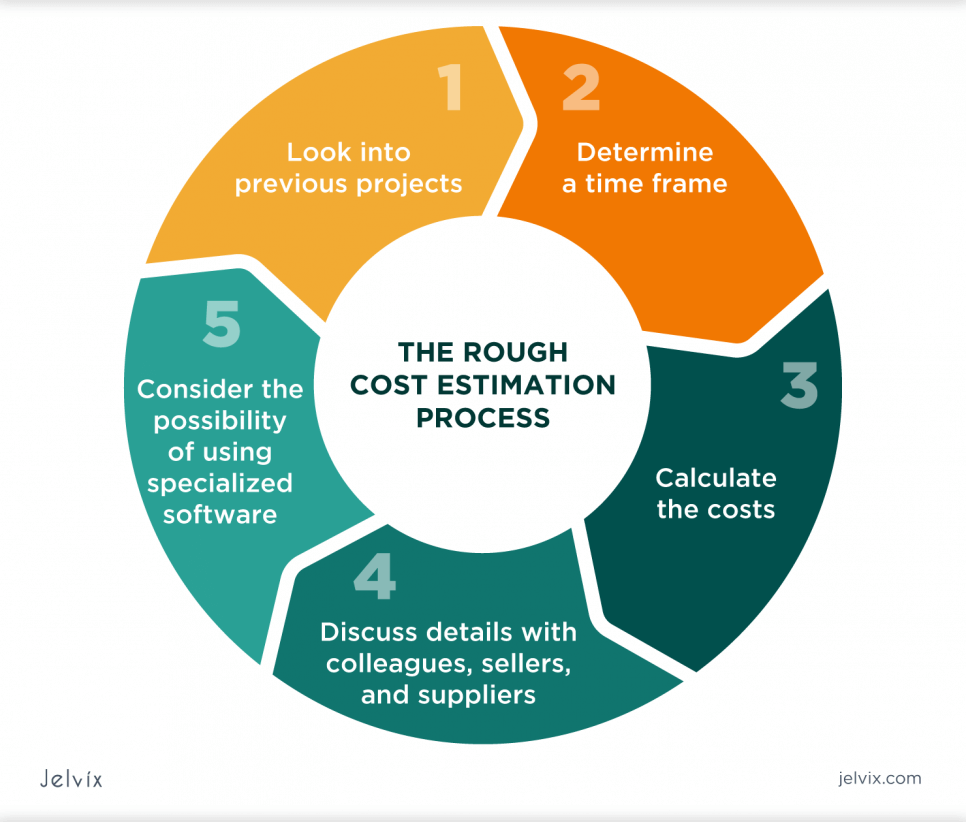Cost estimation is one of the crucial aspects of project management and is standard practice for stakeholders. But in the early stages, project managers rarely have all the information needed to calculate costs accurately. Therefore, they must resort to a rough order of magnitude (ROM) estimate.
What is the ROM estimate meaning? It is a type of valuation used to determine the costs of various projects. The ROM assessment aims to provide stakeholders and decision-makers with an idea of the approximate cost of the construction or IT projects. It is also called “approximate order of magnitude” or conceptual assessment. So, what is the ROM definition? Let’s clarify it in more detail.
Types of Project Estimates You Can Use
Whether you are a software company, manufacturing business, or design firm, your project managers will probably face the common challenge of estimating project scope in terms of costs, schedule, efforts, and risk. Ultimately, before starting a project, you must decide if it is feasible given your company’s budget.
Therefore, the project manager continually defines a rough estimate (ROM) that matches its name. This estimate provides a rough estimate or order of magnitude for the project. In other words, it lets you know if the project will cost $25,000 or $250,000. It also helps define whether the project will last three weeks, three months, or three years.
Rough Order of Magnitude
According to the current PMBOK, ROM has an accuracy range of -25% to +75%. Thus, if the estimate is $ 10,000, a satisfactory result would be in the $7,500 to $17,500 range. Alternatively, you can use a +/- 50% range if the estimate is conservative. But this is only a range. The estimate’s actual accuracy depends on the quality of the cost data and the level of detail that the evaluator places in the forecast.
ROM estimate utilizes a top-down scoring approach. First, the entire project is evaluated, and then individual tasks are isolated. Another method is to break the project down into smaller tasks, which are assessed separately. You can use it in cases when you have strict budgetary constraints but little data about the project’s price.
Why is there a rough order of magnitude? This approach appeared because managers rarely have the information about all the required costs. Therefore, they estimate using their experience and examining suppliers’ charges or other project participants. An estimate of an order of rough magnitude is highly biased and can increase variance. But once the data is available, they can refine the cost estimate to narrow down the wide range of outcomes.
Definitive Estimate
This estimate is based on a bottom-up approach and reflects the project’s ultimate cost. Typically, the method is applied during the planning phase and can be maintained until the project is completed. It is the most accurate estimate, as the difference is -5 to +10 percent.
Anyone who has worked in project management knows how tough it can be to prepare a definitive cost estimate for a long or complex project. That means having to do a significant amount of research. Once you develop a definitive estimate, it usually replaces the previous, less accurate estimate. The refinement of a rough forecast during the project is sometimes referred to as progressive elaboration.
The following estimate types are not listed in the latest edition of PMI’s PMBOK. But, they can be relevant in practice to bridge the gap between the rough order of magnitude accuracy ranges and the definitive estimate.
Budget Estimate
This methodology also uses the “top-down” approach, particularly the analogous estimating technique. Compared to ROM, it has a smaller deviation of -10% to +25%. It is applicable at the conceptual stage of a project when the final specifications are not yet known, but the team already has a core set of features and technical requirements. That helps the stakeholders plan upfront costs and control the budget.
Preliminary Estimate
The accuracy of the technique ranges from -15% to +50%. While this is still not very precise, it is a substantial enhancement compared with the rough order of magnitude range.
Is it Possible to Start a Project Based on ROM Estimates?
It is not for nothing that this term contains the word “rough.” In fact, you cannot start a business based on guesswork. But having received a rough estimate of the project’s cost, you can at least understand whether it is worth starting it.
Discover effective strategies to enhance product development and fuel business growth through digital transformation.
However, you should know you can still launch a project based on a rough estimate. First, if the approximate cost does not bother you, you are prepared that the project’s price may rise. Secondly, if you can afford this cost, even if it increases due to unforeseen factors, you are ready for the launch. This method also actively applies in cases when:
- Your deadlines are tight, your data is limited, and some details are available;
- you have examples of similar models, systems, expertise, and objects;
- you have access to historical data and ratios that you can use;
- you are conducting an analysis that answers the question ”what if”;
- you need to evaluate a specific part of the project or choose from various high-level alternatives to assess which one is the most workable;
- you don’t need to make a quality estimate and detailed analysis.
Why is Cost Estimation Important in Project Management?
Estimating cost is crucial in project management as it is the basis for defining and overseeing the project budget. Costs are estimated at the beginning of a project or even before its start. Subsequently, the (re-) project cost estimation accounts for more detailed information or changes to the scope or timeline.
For example, if the earned value management measures used for controlling project cost show substantial variances from the budget, a re-estimation of the cost and schedule and revisiting the overall budget are inevitable.
Cost estimating is the core activity of project management and planning. Every project has three primary constraints: budget, scope, and time. Cost estimates address the budget constraint; hence, they are highly relevant to project management. The initial rough cost estimate is usually included in the project charter and a business case.
Estimating costs is also essential to the approval of the project sponsor(s). Therefore, the “determine budget” process uses a technique named “cost aggregation,” which directly relates to the outputs of the “estimate cost” process.
Cost estimates are the ground for budget allocation, so the definition and assignment require stakeholder participation, communication, and, in many cases, their approval. In addition, estimates are input parameters for earned value and variance analysis and project cost forecasting.
What projects can you use ROM for?
- Large projects where management information must be provided before all details are received for a definitive estimate.
- International projects may need to include costs from different countries and currency conversions.
- Innovative projects whose results are unique and sometimes unpredictable, so the exact scope of the project is gradually refined or managed through flexible techniques.
- Large budget projects, as small numbers are easier to estimate than large ones.
- Projects with the historical background: NASA’s Pricing Guide, Version 4.0, states that pricing by analogy is a ROM pricing application.
How to Determine the Rough Order of Magnitude
You can turn to whichever methods seem most appropriate for your project when defining ROM. You can utilize these techniques alone or in combination to estimate more accurately.
Expert Judgment
If you or your team have experience with similar projects, you can use peer review. But its accuracy will depend on the team’s knowledge, the clarity of the planned stages, and the project type. The examples of expert judgment are:
- A rough order of magnitude estimate runs at the beginning of a project. Unfortunately, due to a lack of data and staff, more accurate estimation methods (e.g., parametric estimation) are not available at this stage.
- (Re-)estimating the efforts performed to assess resource requirements. This type of peer review can lead to relatively accurate results.
In addition to the fact that peer review is an assessment method, it can be part of other assessment methods like evaluating a previous and current project’s comparability or determining adjustments to parametric estimates.
Analogous Estimation
This method uses data and knowledge from previous or similar projects as the basis for the assessment. It is used when companies need at least some data to decide whether or not to proceed with this project. It is also used when most of the information about the project is not known yet. For example, the app was built in three months and cost $15,000. That means that the new app the team plans to create will cost around $20,000, considering the new features.
The accuracy of this approach is the lowest but the fastest and cheapest. After all, getting data on previous projects is very easy, especially if your team completed the task. When comparing two projects, many variables are considered, such as volume, cost, and duration. But using this method, you assume that all the previous project variables remain the same. This is the fundamental problem. Some variables, such as cost, are constantly changing, affecting the accuracy of the initial calculations.
Parametric Estimation
It is a statistical approach for determining the expected resource requirements. It is based on a proven or suspected relationship between parameters and values. Input data is taken from previous projects or external or internal data sources such as statistics.
Stakeholders often use this type of ROM, meaning construction projects, for example, to determine the cost of materials. But using parametric estimates, you must consider the differences between current and past projects.
Bottom-up Estimation
This methodology includes cost estimates at a detailed unit of work level. The estimates of all project components are then aggregated to determine the total project cost estimate. In practice, these evaluations are often performed at the lowest level in the work breakdown structure, for example, for work activities. And it’s a good practice in project management to ask those members of the project team who are operatively responsible for the respective work activities to evaluate their work.
This approach to cost estimates is often significantly more accurate than top-down estimates. Nonetheless, obtaining and aggregating these detailed estimates is usually resource-intensive and challenging, especially on large or complex projects.
Three-point Estimation
It is a technique that typically leverages bottom-up, analogous, or expert estimates. The concept comprises three valuation points: optimistic (O), pessimistic (P), and most likely (M) cost estimate. The best thing about the three-point estimation is its ability to account for the uncertainty of project lead times and various factors that can slow down or speed up the progress of a project.
Utilizing the three-point technique, you can gain insight into changes in cost and delivery orders of magnitude times of projects. You can use a triangular or beta distribution. A weighted average cost estimate is determined based on these three points that outweigh the “most likely” point. It is customary to use two formulas to calculate the three-point assessed value:
Triangular distribution
This is the average of three and is often used in small, repeating projects.
E = (O + M + P) / 3
Beta distribution
Also named PERT, this method takes a weighted average of three values. It is so-called because the most likely value carries four times the weight of the other two values. This method is mainly used for large, non-recurring projects.
E = (O + 4M + P) / 6
ROM Evaluation Categories
ROM scores are divided according to the level of effort.
Low effort
- Hours to complete: 30 to 50 hours
- Timeframe: 1 or 2 weeks
- Amount of resources: 1 to 2
- Cost: $ 1,500 to $ 4,500.
Average effort
- Hours to complete: 50 to 250 hours
- Timeframe: 1 to 3 months
- Amount of resources: 3 to 5
- Cost: $4,500 to $10,000.
High effort
- Hours to complete: 300 to 1000 hours
- Timeframe: 4 to 6 months
- Amount of resources: from 5 to 15
- Cost: $15,000 to $50,000.
This categorization makes life easier for everyone by breaking down the work in all ways in the early stages of the project. Moreover, it is more convenient for subject experts to estimate using such a model.
The Rough Cost Estimation Process
When you want to estimate costs using an approximate order of magnitude, there are five steps you should take:
1. Look into previous projects
Reviewing projects you have completed in the past can help you calculate the estimated cost of your current project. For example, if you see that the current project will require fewer materials, you can subtract those costs from the current ROM estimate.
2. Determine a time frame
Another key component of a project is time. Determining the duration of work and the time to complete specific tasks is very important for project planning. By evaluating your project schedule, you can bring in the people and resources when you need them. It also allows you to set expectations for clients.
3. Calculate the costs
When making a ROM estimate for a client, start with the basic expenses. For example, when creating a new construction project, some significant expenses may include equipment, vehicles, liability insurance, and space rental. The initial calculation of these costs can give you a clear idea of the overall ROM estimate before determining minor details such as labor and materials.
Don’t use only optimistic values to stay within budget. It can result in teams’ inability to meet deadlines or work with limited resources.
4. Discuss details with colleagues, sellers, and suppliers
When determining a ROM estimate, contact different suppliers and discuss their prices. Some companies may provide you with a quote that you can use as evidence to support your ROM estimate. Although the cost may change as the details of the project become more precise, it will help you outline the expenses during the initiation phase.
Seeking advice from those with extensive project experience can assess ROMs more accurately. For example, third-party project managers can help you calculate the ROM cost or offer feedback on your current ROM estimate. They can also help figure out small project details that they have more experience with, such as labor costs or other miscellaneous expenses that you might have missed.
5. Consider the possibility of using specialized software
Although it is possible to manually estimate the ROM, specialized software can help you make more accurate approximations and automate some calculations. The software can also quickly help you adjust the estimate based on the client’s requirements. For example, if a client increases the project’s size and timing, the program changes the variables to help you calculate the adjustments.
Conclusion
A rough estimate of magnitude is a somewhat imprecise form of estimating a project’s cost. However, it is frequently used in the earliest stages of projects when the information and resources are inaccurate.
In this situation, ROM gives at least a rough idea of the range of project costs, which is often helpful for stakeholders to decide whether to start or abandon a project. The ROM assessment can also be recommended, for example, for developing a project business case or a project charter.
Contact us if you want to know more about Jelvix’s methods for calculating project costs.
Need a certain developer?
Leverage the top skills and resources to scale your team capacity.



